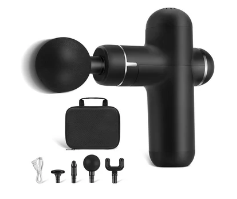The process for using a massager to help relax the body is an excellent technique that helps reduce stress, tension and muscle tension in general. The key to effective use of a massager is proper technique and setting for each area on the body. Well-selected massager will hit the spots you most need, improve circulation and overall help to get into a state of rest very difficult to achieve by any other means.
Choose the Best Massager for You First Most handheld models have speeds that can be changed — anywhere from 1,200 to 3,200 percussions per minute which in turn allow you to control how intense the massage is. When you are looking to decompress, you may want a more gentle treatment at 1,200–1,800 percussions per minute that will deliver some soothing relief but not over-excite your muscles. This speed is particularly useful if you have areas of sensitivity such as your neck and shoulders.
When massaging yourself, it is important to concentrate on the big muscle groups first. Start with the back as it holds the majority of tension. One study published in the Journal of Bodywork and Movement Therapies proved back massages can reduce cortisol levels, which is known as the stress hormone by 30% over just 15 minutes. Slowly work the massager in circular motions up and down the spine, focusing between your shoulder blades; but remember do not press too hard on any vertabra. The idea is to make the muscles warmer, but not too uncomfortable.
Then, the legs and thighs which would be working harder as you use them everyday. The quads and hamstrings in particular respond well to deeper pressure, so notch up the massage gun speed towards 2000-2500 percussions per minute. This will assist with blood circulation and muscle recovery thus allowing for flexibility increase while also preventing injury. According to sports medicine doctor Dr. Jordan Metzl, 'A massager for the legs after you work out can help speed up recovery by improving blood flow and reducing lactic acid concentration.'

A more tender touch is better, especially on the arms and hands where smaller muscles may become fatigued due to repetitive motions. Attach a soft attachment into the massager and turn on at speed about 1,200 percussions per minute Recommendation: Forearms, Palms (from typing or manual labor) By massaging these areas a few minutes daily, that will reduce tension and avoiding to get things like carpal tunnel or anything like this.
Using a massager for body relaxation also requires time management. They advised to make every session 15-20 minutes of excitation on a remedy whereas not over animating. This makes it possible for muscles to relax, without the need of them becoming overworked. Ideally, the complete session should not last longer than 60 minutes when implementing a recovery-based synergy.
Even consistency with that selected skin product is essential in obtaining the best results. By making it a part of your daily or weekly regimen, you can achieve long-term advantages such as better muscle shape and lower levels of stress. The American Massage Therapy Association says regular massage therapy can lower heart rate by six to eight beats per minute and blood pressure, improving overall cardiovascular health. By using a massager regularly, you can enjoy these benefits in your daily life.
Another crucial aspect to ensuring the best massage is staying hydrated By hydrating before and after using the device, this helps to remove some of these toxins (released during your massage routine) from your body resulting in less soreness but also an additional more relaxing effect.
To sum up, in order to relax our body with the massager we must choose a suitable instrument device, regulate the speed and intensity depending on muscle group that is being treated as well as control of length time of each session. These tips, when used correctly can help you to manage stress effectively and reduce muscle tension so that you feel good overall. Click here to search for more body relaxation massagers